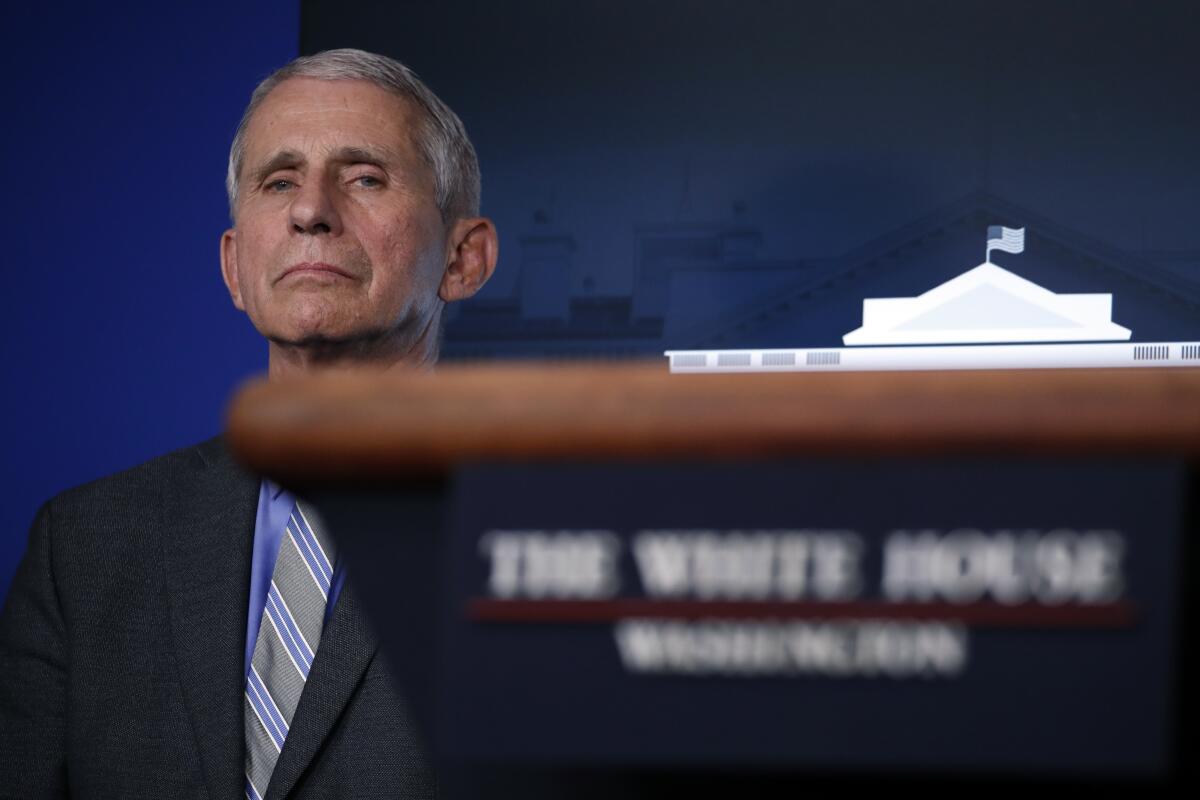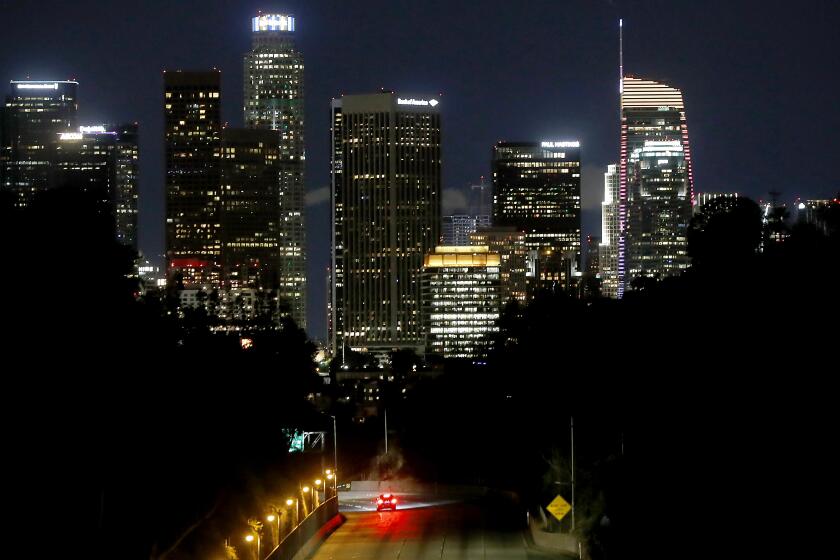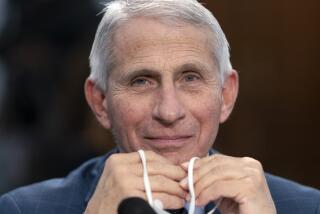‘Time to #FireFauci’: Fauci comments on virus response draw Trump’s ire

- Share via
WASHINGTON — Social restrictions aimed at stopping the spread of the coronavirus could have saved lives if they’d been started earlier, and when they’re eased, new cases are certain to arise, said the nation’s top infectious disease expert, Dr. Anthony Fauci, seeming to draw the ire of President Trump.
Trump, who has been chafing at criticism that he didn’t do enough early on to fight the virus, reposted a tweet that referenced Fauci’s comments and said “Time to #FireFauci.” Trump again pointed to his decision in late January to restrict travel from China, writing, “Sorry Fake News, it’s all on tape. I banned China long before people spoke up.”
Fauci said Sunday that the economy in parts of the country could have a “rolling reentry” as early as next month, provided health authorities can quickly identify and isolate people who will inevitably be infected. Fauci also said he couldn’t “guarantee” that it would be safe for Americans to vote in person on election day, Nov. 3.
When asked on CNN if earlier action on social distancing and stay-at-home policies could have saved lives, Fauci responded in part: “It’s very difficult to go back and say that. I mean, obviously, you could logically say that if you had a process that was ongoing and you started mitigation earlier, you could have saved lives. Obviously, no one is going to deny that. But what goes into those kinds of decisions is complicated.”
Trump’s tweet referencing Fauci was one of several that Trump posted on Sunday that defended his handling of the virus outbreak and blamed others for missteps.
Rather than flipping a switch to reopen the entire country, Fauci said a gradual process would be required based on the status of the pandemic in various parts of the U.S. and the availability of rapid, widespread testing. Once the number of people who are seriously ill sharply declines, officials can begin to “think about a gradual reentry of some sort of normality, some rolling reentry,” Fauci said.
Under growing criticism for his administration’s laggard response to the coronavirus, President Trump has upped his efforts to blame others — including the WHO, Dr. Anthony Fauci, China, governors and the media.
In some places, he said, that might occur as soon as May. “We are hoping that, at the end of the month, we could look around and say, ‘OK, is there any element here that we can safely and cautiously start pulling back on?’ If so, do it. If not, then just continue to hunker down,” Fauci said.
Whenever restrictions ease, he said, “we know that there will be people who will be getting infected. I mean, that is just reality. “
Social distancing guidelines from Trump are set to expire April 30.
Trump is eager to restart the economy, which has stalled because most Americans are under orders to stay at home to help slow the virus’ spread.
But governors will have a lot to say about when to ease restrictions in their states, and the leaders of Maryland and New Jersey indicated Sunday that they were not likely to do so until widespread testing was available.
After the coronavirus pandemic cools down, how will California start getting back to normal? Slowly, methodically and in stages.
“The question is how fast we can get enough tests up to speed in order to help us get to the point where we are able to do all of those things,” Maryland Gov. Larry Hogan said. He said he had set no “artificial deadline.”
New Jersey Gov. Phil Murphy said the risks of reopening too soon were dangerously high. “And I fear, if we open up too early, and we have not sufficiently made that health recovery and cracked the back of this virus, that we could be pouring gasoline on the fire, even inadvertently,” Murphy said.
Increased testing would allow authorities to identify, isolate and trace the contacts of people who are newly infected, Fauci said.
Trump continues to deny ongoing problems with the coronavirus testing that’s available, including shortages and long wait times for people to learn results. He’s also resistant to the idea of more widespread testing, saying last week that “it’s unnecessary” and that “vast areas of our country don’t need this.”
Other scientists have echoed Fauci’s call for a gradual reopening, where restrictions can be ramped up or down.
Dr. Christopher Murray, director of the University of Washington institute, which created widely cited projections of virus-related deaths, said studies showed that lifting restrictions at the end of this month would lead to a rebound in the number of infections. Because states don’t really have the capability to deal with a big volume of new cases, he said, “by July or August we could be back in the same situation we are now.”
Speaking about the prospects of Americans physically going to polling places in November, Fauci said he hoped voting in person could take place.
“I believe that if we have a good, measured way of rolling into this, steps towards normality, that we hope, by the time we get to November, that we will be able to do it in a way which is the standard way,” he said.
“However — and I don’t want to be the pessimistic person — there is always the possibility, as we get into next fall, and the beginning of early winter, that we could see a rebound,” he said.
The U.S. has the most confirmed cases and deaths of any nation, more than 555,000 and more than 22,000, respectively, according to Johns Hopkins University. In hard-hit New York, the number of deaths topped 700 for six straight days, but the increase in people who are hospitalized is slowing, a hopeful sign.
For most people, the new coronavirus causes mild or moderate symptoms, such as fever and cough that clear up in two to three weeks. For some, especially older adults and people with existing health problems, it can cause more severe illness, including pneumonia, and death.
Fauci was on CNN’s “State of the Union.” Hogan appeared on ABC’s ”This Week.” Murray was on CBS’ “Face the Nation.” Murphy was on CNN and CBS.
More to Read
Get the L.A. Times Politics newsletter
Deeply reported insights into legislation, politics and policy from Sacramento, Washington and beyond. In your inbox three times per week.
You may occasionally receive promotional content from the Los Angeles Times.











